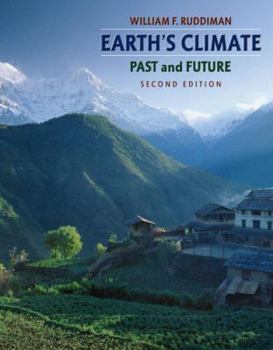Earth's Climate: Past and Future
Select Format
Select Condition 
Book Overview
Offering a clear, engaging, objective portrait of the current state of climate science, Earths Climate acknowledges the evidence is stronger than ever that human activity is the primary cause for... This description may be from another edition of this product.
Format:Paperback
Language:English
ISBN:0716784904
ISBN13:9780716784906
Release Date:October 2007
Publisher:W.H. Freeman & Company
Length:388 Pages
Weight:1.88 lbs.
Dimensions:0.5" x 8.6" x 10.8"
Customer Reviews
4 ratings
an excellent introduction to paleoclimatology
Published by Thriftbooks.com User , 16 years ago
Extremelly well illustrated, this book tackle all aspects of paleoclimatology. I will definitively use it a textbook for our students.
No Doubts
Published by Thriftbooks.com User , 16 years ago
A very good introduction to Quaternary paleoclimatology and projections of things to come. The older edition that I own leaves the question of AGW somewhat open. The latest edition appears to indicate Ruddiman's acceptance of the latest IPCC findings. Recommended for upper division geography and earth science students who've mastered basic meteorology and/or oceanography.
Superb Book on Paleoclimatology!
Published by Thriftbooks.com User , 16 years ago
I am a community college professor who uses this text. The course is designed for non-science majors who need a lab science elective to satisfy their liberal arts degree. The climate course that I teach is a paleoclimatology course which is primarily about the forces that have caused climate and climate change over the past 300 million years. My course differs from the more traditional method of teaching climate (typically an "atmospheric science" course for the first half of the course followed by some climate change materials in the second half.) The Ruddiman book is outstanding and I will highlight the pros and cons below but the pros greatly outweigh the cons: Pros: 1) Extremely well-written 2) Ruddiman uses the scientific method to build his topics. He begins with a hypothesis, explores the data, and then discusses if the hypothesis is valid or not. I love this style because it shows students how scientists approach problems and possible solutions. 3) Superb illustrations Cons: 1) Really a two-semester text. There is no way that students can do more than 10-12 chapters per semester. 2) Although appropriate for college-level, this text will read at a higher level than other books typically used in non-majors courses. Bottom line: this is simply the best climate book I have reviewed to date for community college non-major students and I have reviewed many over the last 20 years.
An excellent introduction of complex processes.
Published by Thriftbooks.com User , 18 years ago
This textbook was assigned for a mid-level course on climatic environments of the past, with a focus on the Quaternary Period. As a graduate student with an ecology undergraduate degree currently studying Quaternary vegetation dynamics, I found this to be an excellent introduction for those without a background in climatology while still having a lot to offer more advanced students. The book itself does not focus merely on the Quaternary, but on the general climatic history of the earth and the dynamic processes that govern it. Ruddiman gives a full treatment of the various scales of variability (tectonic-scale, orbital-scale, millenial, and finally historical and future). He includes a thorough treatment of various paleoclimate proxy methods, the processes of internal and external climate forcing, and gives a geological context for the current trends in climate change. One of the most valuable aspects of this textbook are the excellent illustrations, which are concise and consistent throughout. These graphics make a variety of potentially confusing or complex processes seem much simpler and more approachable, and are superior to other treatments of the same topics I've seen in other textbooks. Each chapter has suggestions for additional readings, key terms, and review questions, making this an excellent resource for students. The work is comparatively up-to-date, and includes current issues and debates in paleoclimate studies as well as references to various contemporary projects, groups, and researchers. The writing style is succinct and clear, and follows an intuitive progression. More advanced students will find it easy to find the information they need without slogging through elementary readings. All in all this is an excellent reference for anyone interested in studying climate dynamics in order to understand current trends. Beginning or advanced students, professionals looking to expand their range of knowledge, and the serious inquirer with an advanced high school background in physical science will all find something valuable in this text. My only wish is that the book, now five years old, be updated to include the most recent advanvements in the field.





